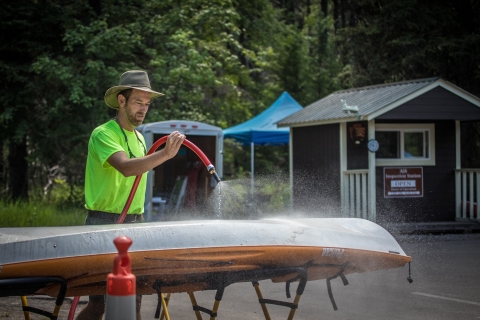Shiawassee National Wildlife Refuge and partners are empowering people to fight aquatic invasive species invasive species
An invasive species is any plant or animal that has spread or been introduced into a new area where they are, or could, cause harm to the environment, economy, or human, animal, or plant health. Their unwelcome presence can destroy ecosystems and cost millions of dollars.
Learn more about invasive species .
Shiawassee National Wildlife Refuge is 10,000 acres sitting at the convergence of four major rivers in central Michigan. The rivers support wildlife, power the economy, and offer opportunities for recreation. Wildlife species that can be found in the area include lake sturgeon, bald eagles and many species of migratory birds.
Over the past decade recreational use of the rivers and the refuge has risen dramatically and habitat restorations have reconnected floodplains that were cut off from the rivers for more than 100 years, expanding habitat for native fish. But all that additional use and connectivity has the potential to introduce new aquatic invasive species into the Refuge.
Aquatic invasive plants like European frog-bit can choke out native plants and wildlife, and species like zebra mussels damage infrastructure and upset the ecosystem. Many aquatic invasive species - including plants, fish, and mussels - can be accidentally transported from one body of water to another by people go fishing and boating.
Volunteer and non-profit groups have been working with agencies to protect water quality and river access, but aquatic invasive education and prevention is increasingly essential.
In 2022 the refuge and conservation partners launched a project to help people prevent invasive species from entering the refuge. The project will place cleaning stations at boat launches, install interpretive signs at each station, and host public events on the Refuge and with partners to introduce the new equipment to the public.
The signs will help teach boat launch users how to identify and prevent the spread of invasive plants and animals. The refuge will work collaboratively with Wildlife Forever, the National Park Service, and the local community through the Saginaw Bay Cooperative Invasive Species Management Area, to make invasive species prevention a community priority.
Clean, Drain, Dry… after every waterbody, every time.
By following a few simple steps boaters and anglers can help prevent the spread of aquatic invasive species and protect the wildlife and the environment.
Before you leave the water:
CLEAN off visible aquatic plants, animals, and mud from all equipment.
DRAIN motor, bilge, live well, and other water containing devices.
DRY everything for at least five days OR wipe with a towel before reuse.
DISPOSE of unwanted bait, worms, and fish parts in the trash.
Together the steps of Clean Drain Dry and Dispose greatly minimizes the risk of spreading aquatic hitchhikers into new locations.






